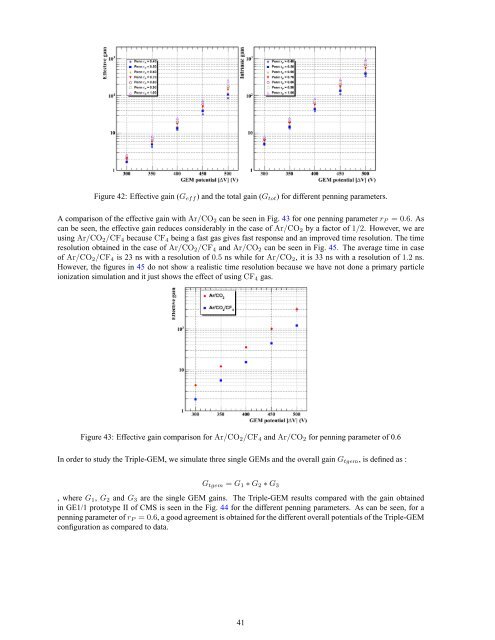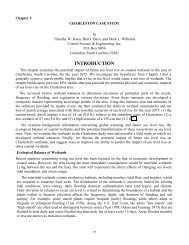A GEM Detector System for an Upgrade of the CMS Muon Endcaps
A GEM Detector System for an Upgrade of the CMS Muon Endcaps
A GEM Detector System for an Upgrade of the CMS Muon Endcaps
You also want an ePaper? Increase the reach of your titles
YUMPU automatically turns print PDFs into web optimized ePapers that Google loves.
Figure 42: Effective gain (Geff ) <strong>an</strong>d <strong>the</strong> total gain (Gtot) <strong>for</strong> different penning parameters.<br />
A comparison <strong>of</strong> <strong>the</strong> effective gain with Ar/CO2 c<strong>an</strong> be seen in Fig. 43 <strong>for</strong> one penning parameter rP = 0.6. As<br />
c<strong>an</strong> be seen, <strong>the</strong> effective gain reduces considerably in <strong>the</strong> case <strong>of</strong> Ar/CO2 by a factor <strong>of</strong> 1/2. However, we are<br />
using Ar/CO2/CF4 because CF4 being a fast gas gives fast response <strong>an</strong>d <strong>an</strong> improved time resolution. The time<br />
resolution obtained in <strong>the</strong> case <strong>of</strong> Ar/CO2/CF4 <strong>an</strong>d Ar/CO2 c<strong>an</strong> be seen in Fig. 45. The average time in case<br />
<strong>of</strong> Ar/CO2/CF4 is 23 ns with a resolution <strong>of</strong> 0.5 ns while <strong>for</strong> Ar/CO2, it is 33 ns with a resolution <strong>of</strong> 1.2 ns.<br />
However, <strong>the</strong> figures in 45 do not show a realistic time resolution because we have not done a primary particle<br />
ionization simulation <strong>an</strong>d it just shows <strong>the</strong> effect <strong>of</strong> usingCF4 gas.<br />
Figure 43: Effective gain comparison <strong>for</strong> Ar/CO2/CF4 <strong>an</strong>d Ar/CO2 <strong>for</strong> penning parameter <strong>of</strong> 0.6<br />
In order to study <strong>the</strong> Triple-<strong>GEM</strong>, we simulate three single <strong>GEM</strong>s <strong>an</strong>d <strong>the</strong> overall gain Gtgem, is defined as :<br />
Gtgem = G1 ∗G2 ∗G3<br />
, where G1, G2 <strong>an</strong>d G3 are <strong>the</strong> single <strong>GEM</strong> gains. The Triple-<strong>GEM</strong> results compared with <strong>the</strong> gain obtained<br />
in GE1/1 prototype II <strong>of</strong> <strong>CMS</strong> is seen in <strong>the</strong> Fig. 44 <strong>for</strong> <strong>the</strong> different penning parameters. As c<strong>an</strong> be seen, <strong>for</strong> a<br />
penning parameter <strong>of</strong>rP = 0.6, a good agreement is obtained <strong>for</strong> <strong>the</strong> different overall potentials <strong>of</strong> <strong>the</strong> Triple-<strong>GEM</strong><br />
configuration as compared to data.<br />
41
















